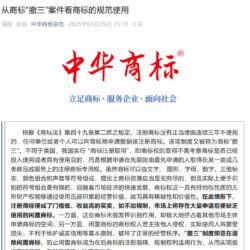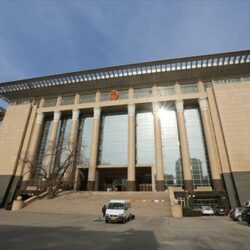The principle of change of circumstances is not only applicable to the first and second instance proceedings, but also to the re-trial proceedings. In other words, if after the first or second instance judgment is made, the reason for the rejection of the applied trademark no longer exists (e.g. the cited trademark is found to be cancelled or declared invalid by the effective judgment), the parties can apply for a retrial. And in the retrial procedure, according to the principle of change of circumstances, the court can order CNIPA to make a new decision according to the new facts, that is, the original rejected trademark can be re-registered.
Parallel actions with unparallel procedures
In
practice, after a trademark application is rejected for an earlier filed cited
trademark, the trademark applicant can usually take measures to clear the cited
trademark such as cancellation and invalidation, in addition to arguing that
the trademark is dis-similar during the review procedure.
practice, after a trademark application is rejected for an earlier filed cited
trademark, the trademark applicant can usually take measures to clear the cited
trademark such as cancellation and invalidation, in addition to arguing that
the trademark is dis-similar during the review procedure.
However, the
trademark cancellation and invalidation period is generally longer than that of
trademark rejection review cases. For example, after the completion of
cancellation procedure in CNIPA (the former State Intellectual Property Office),
the cited mark may still go through the review procedure, and after the
completion of the review procedure there may be corresponding follow-up
administrative litigation. In parallel the rejection review of the applied mark
and follow-up litigation procedure will not be suspended.
trademark cancellation and invalidation period is generally longer than that of
trademark rejection review cases. For example, after the completion of
cancellation procedure in CNIPA (the former State Intellectual Property Office),
the cited mark may still go through the review procedure, and after the
completion of the review procedure there may be corresponding follow-up
administrative litigation. In parallel the rejection review of the applied mark
and follow-up litigation procedure will not be suspended.
Therefore,
in many circumstances, after the prosecution and litigation procedures of the
applied mark are all completed, the cancellation or invalidation procedure of
the cited mark is still ongoing. There is no question that the applied mark will be faced with the
rejection outcome.
On the other hand, during the backup reapplication, the reapplied mark will
continue to be rejected because the cited mark is still valid. In addition, the
examiner may cite new prior filed similar trademarks, further increasing the
difficulties of registration of the applied mark.
Therefore, it is a relatively
safe and least risky solution for the applicant to obtain trademark
registration through the first round of rejection review procedure.
Questioned Procedure
After the applied mark is finally rejected, provided that a
judgment of cancellation or invalidation of the cited mark comes into effect,
is it possible to retrieve the finally rejected applied mark? In other words,
whether the judgment of cancellation or invalidation of the cited mark has
retrospective effect on the final rejection of the applied mark.
judgment of cancellation or invalidation of the cited mark comes into effect,
is it possible to retrieve the finally rejected applied mark? In other words,
whether the judgment of cancellation or invalidation of the cited mark has
retrospective effect on the final rejection of the applied mark.
According
to Article 28 of the Provisions of the Supreme People’s Court on Several Issues
Concerning the Trial of Administrative Cases of Trademark Authorization and
Determination of Rights, in the course of the trial of trademark administrative
cases, if the cause and reasons of rejection is no longer exists due to change
of circumstances, the court may revoke the relevant CNIPA decision based on the
new facts, and order CNIPA to make a new decision based on the changed facts.
The
above provisions set up the Principle of Change of Circumstances in the
trademark prosecutions, which can be directly applied in the first instance and
second instance of the trademark administrative litigation. And it can also be
applied in the retrial process of the applied mark.
The
following three cases can be used as reference.
Case
Background
The applied mark
of rejection review with China Supreme People’s Court, requesting a correction
of the prior court judgments.
The
Supreme Court ruled that:
After
the judgment of the second instance of the applied mark was made, the cited
mark was revoked by the Trademark Office on the ground of ceasing use for three
consecutive years. No parties had initiated subsequent administrative and
judicial review procedures on the cancellation decision of the cited mark, the
cancellation decision came into effective.
Since China’s trademark law adopts a
registered trademark review system. During the review period, it is objectively
impossible to avoid possible changes in circumstances, which is part of the
design of the trademark registration system. Therefore, in the trademark
rejection review litigation, the examination procedure for registration of the
applied mark has not yet been completed.
registered trademark review system. During the review period, it is objectively
impossible to avoid possible changes in circumstances, which is part of the
design of the trademark registration system. Therefore, in the trademark
rejection review litigation, the examination procedure for registration of the
applied mark has not yet been completed.
In this process, since the factual
basis of whether the applied mark should be approved for registration has fundamentally
changed, i.e. the only obstacle in this case has disappeared. If the court
still based on the factual state at the time of the second instance judgment to
consider whether the applied mark should be approved or not, it will lead to an
obvious unfair result.
basis of whether the applied mark should be approved for registration has fundamentally
changed, i.e. the only obstacle in this case has disappeared. If the court
still based on the factual state at the time of the second instance judgment to
consider whether the applied mark should be approved or not, it will lead to an
obvious unfair result.
Accordingly, according to the principle of change of
circumstances, the SPC corrected the conclusion of both the first and second trial
judgments, ordered the Trademark Office to consider the application of the
applied mark based on the new facts.
circumstances, the SPC corrected the conclusion of both the first and second trial
judgments, ordered the Trademark Office to consider the application of the
applied mark based on the new facts.
So
after application for over 11 years, the applied mark is eventually registered
in 2016.
after application for over 11 years, the applied mark is eventually registered
in 2016.
Case
Analysis and Tips
The
principle of change of circumstances is not only applicable to the first and
second instance proceedings, but also to the re-trial proceedings. In other
words, if after the first or second instance judgment is made, the reason for
the rejection of the applied trademark no longer exists (e.g. the cited
trademark is found to be cancelled or declared invalid by the effective
judgment), the parties can apply for a retrial. And in the retrial procedure,
according to the principle of change of circumstances, the court can order
CNIPA to make a new decision according to the new facts, that is, the original
rejected trademark can be re-registered.
principle of change of circumstances is not only applicable to the first and
second instance proceedings, but also to the re-trial proceedings. In other
words, if after the first or second instance judgment is made, the reason for
the rejection of the applied trademark no longer exists (e.g. the cited
trademark is found to be cancelled or declared invalid by the effective
judgment), the parties can apply for a retrial. And in the retrial procedure,
according to the principle of change of circumstances, the court can order
CNIPA to make a new decision according to the new facts, that is, the original
rejected trademark can be re-registered.
Combining
the above three cases, we summarize the following tips and suggestions for
trademark rejection review cases, so that trademark applicants can avoid risks and
make proper decisions when faced with the difficult choice of whether to
continue litigation.
- Because of the long time required to clear the obstacles to the cited mark,
trademark applicants are discouraged and reluctant to continue with the
rejection review case. However, the reapplication may encounter other
obstacles, which may result in the reapplication still not being successfully
registered. If the trademark applicant decides to or has already taken measure
to remove the cited mark, it is recommended to start and continue the rejection
review proceedings and wait for the success of the clearance procedure, and
then obtain the final success of the rejection review.
- Regarding
the first instance judgment of the administrative litigation of trademark
rejection, if the grounds of trademark rejection no longer exist after the
judgment takes effect, even if there is no second instance litigation, it is
also possible to apply for re-examination of the first instance administrative
litigation judgment of rejection based on the principle of change of
circumstances. Therefore, if it is predicted that there will be no final result
of the cancellation or invalidation of the cited mark before the conclusion of
the second instance proceedings of the rejection review, and the situation of
suspension is not met, there is no need to continue the second instance
proceedings of the rejection review. The applicant can apply for the retrial of
the first instance judgment of the rejection review case within six months
after receiving the effective judgment that the cited trademark is deemed to be
cancelled or invalidated.
- For the second instance judgment of the administrative litigation of trademark
rejection and review, if it is predicted that there will be no final result of
the cancellation or invalidation case of the cited mark before the conclusion
of the retrial, and there is no other objection to the facts and legal
determination of the case, the trademark applicant can apply for retrial of the
second instance judgment of the rejection review case within six months after
receiving the effective judgment that the cited trademark is deemed to be
cancelled or invalidated.



